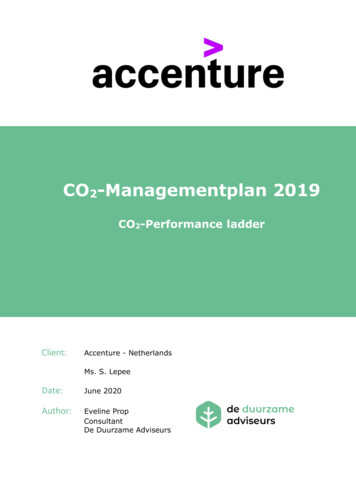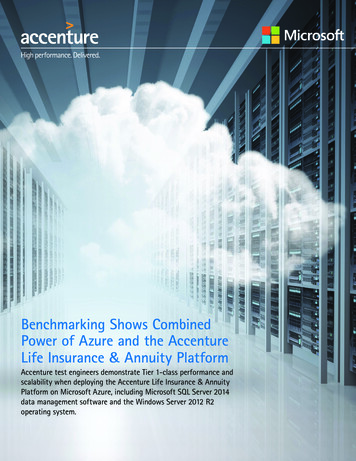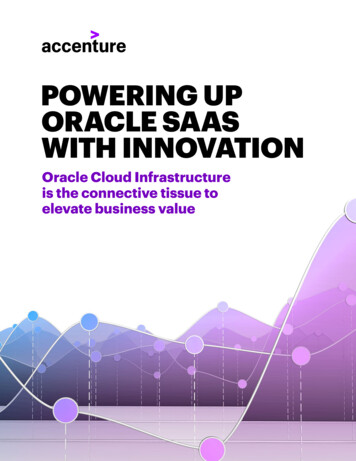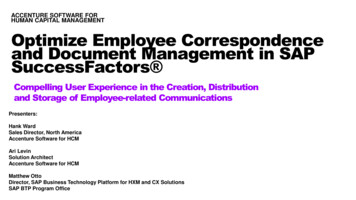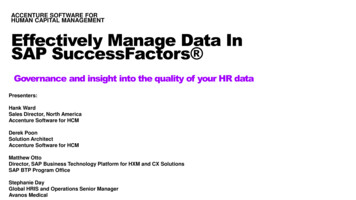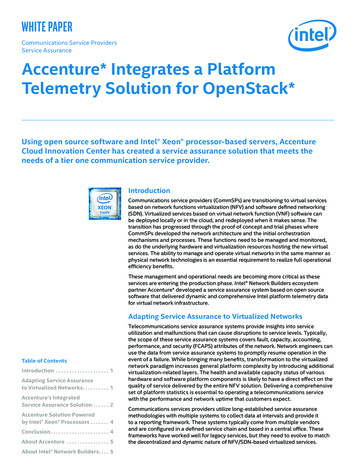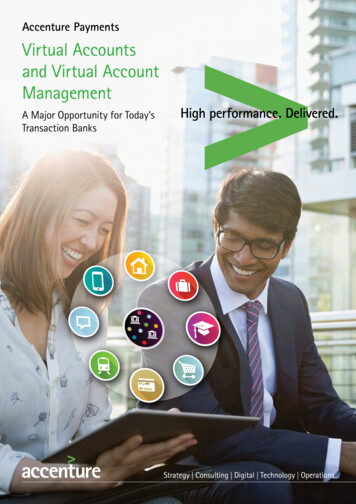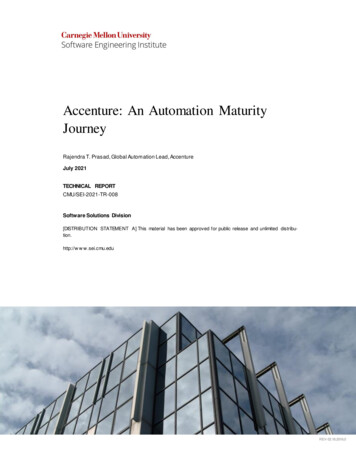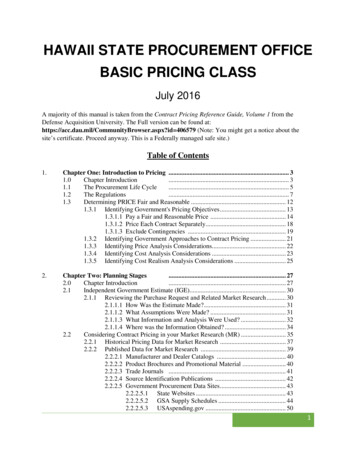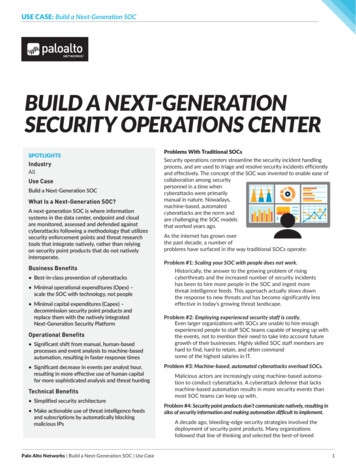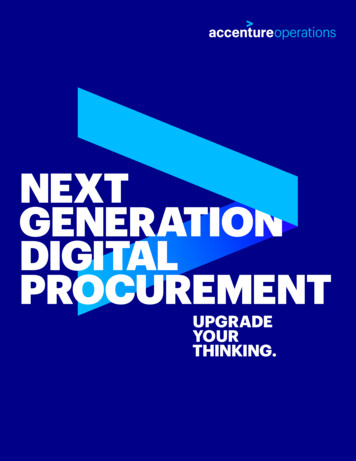
Transcription
G.
NEXT GENERATION DIGITAL PROCUREMENTDIGITALPROCUREMENT:THE FUTUREBEGINS TODAYThe procurement organizationhas been largely left behindin the digital revolution.That needs to change.With digital, bots will automate and streamline manual,routine procurement tasks. Buying agents and advisorsare expected to help people make the best purchasingdecisions, delivering optimal value to the business. Andthe familiar frustrations surrounding procurement todaywill give way to a simple and intuitive buying experiencethat users will enthusiastically embrace. This is possible.This is the future. And it starts now.2
NEXT GENERATION DIGITAL PROCUREMENTWhy Digital Procurement,and Why Now?As digital disruption sweeps across all industries, companiesface unprecedented competitive pressures. Digital is creatingnew channels for customer and partner interaction that areupending core business models and industry dynamics. In turn,companies see their future relevance and viability under fire.Business leaders know their companies should become much moreagile and efficient than they’ve ever been to survive and thrive in thisnew world. That’s why companies are racing to embrace digital totransform key areas of the business. Customer-facing ones such asmarketing, sales, and service, as well as many important supply chainfunctions, have been the prime targets.To date, procurement hasn’t commanded the same kind ofattention or investment. True, companies have enthusiasticallyembraced eProcurement systems and even cloud-basedprocurement tools. But it’s time to move beyond simply replicatingthe same tedious procurement processes with new software.Leading companies are taking the next step and create a truedigital procurement organization.A true digital procurement organization automates repeatabletasks to boost efficiency and potentially drive down costs. It equipsstakeholders across the business with real-time access to insightsand analytics through artificial intelligence (AI) and easy-to-use onlinetools. It deploys new and smarter ways to infuse data models to enrichday-to-day operations and decision making. And it transforms howbuyers interact with suppliers and other third parties by serving asa platform for new levels and types of collaboration.In essence, digital procurementenables the ‘Amazon-like’ experienceemployees now want—but currentlyaren’t getting—in the workplace.3
NEXT GENERATION DIGITAL PROCUREMENTWhy is Making ProcurementMore Attractive to Stakeholdersso Important?Stakeholders expect the ease and elegance from the “procurement”tasks they do at home as consumers on Sunday to apply to the workthey do for the company on Monday. But current procurementpolicies and tools are geared toward driving a process—with a lotof rigor and controls—versus an experience or outcome. So it’snot a surprise that stakeholders find the procurement processtoo cumbersome, slow, and rigid. In their minds, Procurementis an obstacle to be avoided rather than a useful tool.Conversely, digital procurement is defined not by a rigorous process butby deep and rich data. It assumes business controls are built into AI modelsso users can do what they want to do without having to go through manypainful steps. Thus streamlining and simplifying how people make andexecute buying decisions, digital procurement encourages stakeholdersto “embrace the process” instead of circumventing it in favor of theexperience they prefer. In other words, users aren’t necessarily fully awareof procurement’s influence and guidance, and they don’t feel like they’re“going through a process.” They simply see valuable information presentedthat they can act on. Compliance and controls are inherent and embeddedin the model instead of being visible obstacles to be overcome.It’s critical to increasing the procurementorganization’s influence over the half of thecompany’s spend it doesn’t control—and,by extension, increasing the effectivenessof how that spend is managed.4
NEXT GENERATION DIGITAL PROCUREMENTFor example, consider Joan in the marketing department,who is responsible for the department’s spend.Via a dashboard on her laptop or mobile device, she has real-time visibilityand information about all the department’s past and current spend—howmuch, on what goods and services, and with which suppliers. But evenbetter, she has access to an intelligent agent that helps guide her buyingdecisions. The agent draws on a vast array of transaction and contextualdata, as well as market intelligence and category expertise it has learnedfrom the company’s category experts and its own experience, to help Joanthrough the buying process and choose the right approach.It can tell Joan:51That a relevantcontract alreadyexists (and candraft the contractfor her)The fair marketpricing to createa new videocontent asset42The most qualifieddigital agenciesand their relativeperformance3Whether she canrequest a quotedirectly from theagency or needsto involveprocurementWhether the agencyneeds to issue astatement of workwith the appropriatecontract termsAided by this data-rich, analytics-driven, and AI-enabled process, Joan canexecute her video project confidently, knowing she made the best possibledecision for her department and the company.5
NEXT GENERATION DIGITAL PROCUREMENTDigital is the Foundationof Procurement 3.0Digital procurement isn’t just the next phasein IT’s evolution. It’s a genuine step-change—a dramatic departure from both procurement’suse of technology and its operating model of thepast few decades (Figure 1).Today, the vast majority of companies have whatwe’d call a Procurement 1.0 organization. This ischaracterized by a focus on using technologyto automate processes and record what hashappened: a transaction executed, an invoicepaid, an item purchased, a contract signed. And,unfortunately, it’s also marked by systems of record(in the form of software) that generally have madethe procurement process overly complex andunpleasant to navigate from a user’s perspective.Some leading procurement organizations aremaking strides toward 2.0, in which they’re usingtechnologies to dig deeper to get much morecontextual information about what happened andwhy (see “Example: Capturing the Context”). Suchinformation is critical: It’s foundational to buildingAI-enabled predictive models that help improvefuture decision making, and are at the heart of aProcurement 2.0 organization.6Example:Capturing the ContextRecording the “why” and the context around specificpast transactions is vital to making far more informedfuture purchasing decisions.For instance, let’s say your company needs a newboiler. Knowing that you bought a boiler two yearsago from Acme Advanced Supplies (Acme) for 230,000 is useful information. But today, you’relooking at the market for boilers and trying todetermine who should provide the boiler for yournext location and what an appropriate price shouldbe. That means you also need two other key piecesof information: the alternatives that were consideredas part of the purchase two years ago and the factorsthat led to the decision to choose Acme.As it turns out, in addition to Acme, you bid thiscontract out to three other suppliers, and two ofthose suppliers’ prices were lower and one washigher. One of the lower-priced suppliers offereda less-efficient boiler that would have actuallyincreased Total Cost of Ownership (TCO) over thelifetime of the equipment. The other lower-pricedsupplier required customers to order spare partsthrough a non-preferred vendor. The highercost provider’s product exceeded the needs ofthis specific project, making the increased costimpossible to justify. Acme won the business becauseits offering met all requirements and provided a lowTCO option that also aligned with adjacent sourcingstrategies for parts and maintenance contracts.Within the next two to four years we’ll see theemergence of Procurement 3.0. That’s whenprocurement and the business will operate and interactwith information outside their own data ecosystem, andintelligent capabilities will go beyond simply executingtransactions to actually guiding (and in some cases,making) business decisions.
NEXT GENERATION DIGITAL PROCUREMENTFIGURE 1: THE EVOLUTION FROM PROCUREMENT 1.0 TO 2.0 TO 3.03.02.01.0Operate and interact withinformation outside yourown data ecosystem;intelligent capabilitiesguide business decisions,not transactionsRecording whydecisions are madein the procurementprocess; the context;the context within yourown universe of dataRecording data andtransactions throughuse of eProcurementtechnologies;digital processmanagement C ognitive guidessourcing strategy Who won / who lost / why Who won Provides context for if / than Price paid Real-time Twitter monitoringtranslates and interpretspotential supplier risk7
NEXT GENERATION DIGITAL PROCUREMENTFive Elements Are Key to MakingDigital Procurement a RealityWith digital procurement, a company can dramatically improveprocurement’s speed, agility, and efficiency.Digital procurement gives decision makers better visibility, reducesrisk, and boosts compliance—ultimately increasing spend undermanagement and driving more value for the business. But adoptingdigital procurement is a tall order. It requires what we call a “compoundsystem of knowledge,” which encompasses five key elements that mostprocurement organizations struggle to fully implement or operate.DATATECHNOLOGYTOOLBOXINTUITIVE USEREXPERIENCESSKILLS ANDTALENTNEW POLICIES,PROCEDURESAND OPERATINGMODEL8
NEXT GENERATION DIGITAL PROCUREMENTExample:How Digital Procurement Transformsthe Way Companies Purchase EnergyDigital procurement can dramatically enhance the jobs of those who workin the corporate procurement organization. The energy spend categoryis a great example. Years ago, most companies received and paid billsfrom energy utilities without question, similar to how many consumersstill pay their home energy bill today. However, competitive pressures onprocurement organizations, combined with a proliferation of energy usageand pricing data, have created a digital revolution in the way companiesprocure energy.Building Management Systems track temperature, humidity measurements,occupancy, and lighting levels against location-specific set points to ensureenergy is not over-used (which leads to excess cost) or under-used (which canlead to occupant complaints). Such systems communicate with corporate controlcenters, which also monitor equipment such as roof-top units and refrigerationfor signs of wear or malfunctions (which would otherwise lead to excess cost orearly failure) and dispatch service technicians to resolve issues prior to equipmentfailure. Augmenting all these people, systems, and sensors is optimization software,which controls equipment cycling and set points across a portfolio of sites to takeadvantage of energy price signals that fluctuate hourly and vary by utility.But next-generation digital procurement goes even further than that. Largecorporate energy users today use hedging and purchasing techniques akin to thoseused by only the utilities in the past. In addition to monitoring real-time energyprice signals, users keep tabs on forward (futures) price signals on a daily basisand apply multi-tranche layering strategies to slowly step into a contract price forenergy instead of making an all-at-once purchasing decision (i.e., “Did I pick theright day or the wrong day to buy?”). In fact, the largest energy users are no longerprice takers; instead, they forecast prices on their own and set production andpurchasing schedules accordingly.Next-generation procurement even can disrupt vendor business models. Largecorporate energy users are increasingly buying power directly from renewablegenerators directly, bypassing traditional energy suppliers and utilities. Often timesthis energy is delivered “virtually” via a financially settled contract instrument. Thisleaves a utility company to still deliver physical power at a varying price but enablesthe end user to lock in a price independently through a third party. In other cases,the energy is generated onsite, eliminating the need for a utility company to beinvolved at all or offering a way to displace purchases made from the utility.9
NEXT GENERATION DIGITAL PROCUREMENTDATAThe main fuel for a digital procurement organization is data—and lotsof it. Data underpins everything a company could do to predict the needsof people, know which goods or services are available to best meet thoseneeds, determine which suppliers are the right ones, and identify theright price to pay.But in most companies, procurement can’t harness the explosion of dataavailable about suppliers, pricing, the market, and other key factors to makemore informed business decisions. Traditionally, they only gather transactioninformation and, maybe, line-item data. They’re missing the contextualinformation surrounding purchasing decisions—especially the processdata related to the steps they take to, for example, review and approve arequisition, set up a contract, or go through an RFP. They’re also not tappinginto the vast range of important external and third-party data.To build a true digital procurement organization, companies should consideran intentional strategy to capture far more data internal and external—thanthey do today: Everything the organization touches—not only in its sourcing process,but in any process generating data that’s relevant to procurementand sourcing. This includes invoice and payment data to understandcompliance with price and process, as well as process information,such as who approved a price variance and for how much. Data outside the organization, such as deep and broad categoryand market intelligence, which is arguably even more important.Such data is critical to developing the greatest insight into the TCO orpricing levers the company can consider when negotiating an individualcontract. And it’s vital to understanding which is the right item to buyand from whom. But due to the sheer volume of relevant data available,this is an area where most procurement organizations are particularlydeficient. It’s also a gap that’s really hard for any one company to closeon its own.The data procurement needs falls into two broad categories. The firstis data that can be leveraged to create information that in and of itselfhas intrinsic value—for instance, a supplier profile, market overview,or descriptive analytics about the average price of a good or a servicein a geographic market. The second is data that can be used to discovercorrelations between the characteristics of sourcing decisions and profitoutcomes, and to build analytics-based predictive models and ultimatelyartificial intelligence. This is why a company should collect everything itcan—the “X” that drives “Y” in a model is not always intuitive or obvious.10
NEXT GENERATION DIGITAL PROCUREMENT11TECHNOLOGY TOOLBOXIf data is the fuel for digital procurement, technology is its engine.And by technology, we don’t mean ERP-type systems (in the cloud orotherwise) designed to support a process. Rather, we’re talking abouttechnologies that harness and make sense of data—especially AI, naturallanguage processing, analytics, and bots. By combining relevant dataand these highly-advanced technologies, a company can automate andenhance a wide range of activities and processes—and, in some cases,go beyond simple automation to providing advanced intelligent support.Think about plotting, on a two-dimensional matrix, every action and taskthat’s executed in the end-to-end procurement process: Judgment complexityis on one axis, and the degree to which the input to that task or that action isstructured versus unstructured is on the other (Figure 2).Any activity or process that involves a high degree of both structuredinformation (such as a supplier name, category, commodity code, discreteitem description, or SKU number) and rules-based processing (“if X, thendo Y”) can and should be automated to accelerate execution and improveefficiency. This is the domain of bots.The technologyneeded to use datain such innovativeways exists today.And as it matures,it will move to theheart of virtually allprocurement-relateddecisions.Here’s a simple example: Using Robotic Process Automation (RPA)—a.k.a. bots—a company can automatically, with no human intervention, convert a requisitionto a purchase order when all required fields are complete and accurate.Some existing procurement tools already support basic automation, such asautomatically validating and assigning category and general ledger codes.On the other hand, when an activity or process is subject to a high degreeof judgment and involves a lot of unstructured information, automation takesthe form of predictive models and artificial intelligence that intelligent agentsrely on to help humans make better, more informed decisions.For instance, when determining which suppliers to use in a sourcing eventor spot buy, an intelligent agent will apply a complex model based on thesourcing and buying history of the items being sourced, supplier ratings andperformance, and recent supplier pricing to recommend—and eventuallychoose—the suppliers that should be involved.FIGURE 2: AUTOMATION VERSUS INTELLIGENT SUPPORTPUREAIBLENDEDTECHNOLOGIESRPATENDS TO HAVEUNSTRUCTUREDDATAHAS A MIX OF STRUCTURED ANDUNSTRUCTURED DATATENDS TO HAVESTRUCTURED DATATENDS TO BE JUDGEMENT AND RULE BASEDTENDS TO BE RULEBASEDTENDS TO BEJUDGEMENT BASED
NEXT GENERATION DIGITAL PROCUREMENTINTUITIVE USER EXPERIENCESTo fully benefit from digitalization of procurement, a companyshould provide an attractive, intuitive user experience thatencourages stakeholders to use the online procurement tools.The more people who use these digital capabilities, the moreeffective they are in buying and the more data the organizationcan collect on specific transactions.Without a compelling user experience, people will find a way aroundusing the digital tools—whether by not buying something they reallyneed because it’s just too difficult or time consuming, or figuringout another way to get it.In digital procurement, the ideal experience is akin to that deliveredby Amazon.com, Inc or HomeAdvisor, Inc: There’s a single dashboardor portal that serves as the starting point for every interaction,and that presents insights and information succinctly so the rightdecision or action is obvious to users. All the “messy stuff” happensin the background, far beyond the user’s notice. By using intelligentalgorithms, the system can provide recommendations to users insteadof forcing them to manually search a database. That’s much like howAmazon’s product recommendations minimize the need for customersto sort through Amazon’s offerings for other things they might want.12
NEXT GENERATION DIGITAL PROCUREMENTSKILLS AND TALENTThere’s more to creating and operating a digital procurementorganization than simply collecting more data and applyingdigital tools. Generating true value requires another key element,a cross-functional team of people with distinctly different skills: Data scientists and AI experts who understand how to buildand apply models to manipulate the data and tease outdifferent correlations. Category/business experts who can advise whether thosecorrelations are significant or simply coincidences. IT professionals who understand the technology tools andsoftware applications, and how to integrate them to createa solution to a problem that actually adds value (not tomention how to incorporate them into the company’sexisting IT infrastructure). Design professionals who are adept at developing compellingexperiences that make stakeholders want to use the toolsprovided rather than find ways to avoid them.The fact is, procurement should build deep skills across all fourof these areas and combine them in ways that amplify outcomes.Investing in any one of them is not enough, nor is investing in allwithout a cohesive vision for how they work together to enable thedigitalization journey. And this is an area in which most procurementorganizations really struggle. Simply adding enough category andbusiness specialists is hard enough. When you couple that with thehuge challenge of finding and hiring qualified data scientists andtechnologists, it’s easy to see that closing the talent gap is oneof the biggest obstacles a procurement organization will facein becoming truly digital.NEW POLICIES, PROCEDURESAND OPERATING MODELDigital procurement gives all stakeholders—company employeesand suppliers—a new way to collaborate and interact, as well asaccess to more robust data and insights.But to fully benefit from these new capabilities, a companyshould review its policies and procedures and ensure everyoneunderstands their roles and responsibilities in the new procurementprocess and how they can make the most informed decisions.It’s also likely a new or dramatically different procurement operatingmodel will be needed to reflect the new ways of working.13
NEXT GENERATION DIGITAL PROCUREMENTThree Considerationsfor Moving ForwardAs digital technologies continue to evolve and leadingedge capabilities such as AI become more accessible,the opportunities to vastly improve procurement’sperformance and contributions skyrocket.A fully digital procurement model dramaticallyincreases compliance, puts a far greater amountof spend under management, potentially increasesoverall savings, and significantly reduces risk. And itwould do so seamlessly. In effect, it challenges theperception that working with procurement makesthings harder, and that procurement only cares aboutsaving money. But even more important, digitalprocurement is a competitive necessity: Continuingto run antiquated procurement processes can stuntgrowth and prevent organizations from pivoting to thenew—whether that’s selling new products, selling tonew customers, or adopting new business models.14IT TAKES TIMEThere’s a very long runway to getting up to speedand actually using digital procurement capabilities.You can’t just flip a switch and begin using AI to powerbuying decisions. In our experience, it typically takesthree to five years to collect the relevant data, developthe necessary systems and processes, and build theunderpinning analytics and AI. That’s why it’s criticalfor companies to begin moving today.IT TAKES MONEYBuilding a digital procurement organization alsorequires a big investment. Fortunately, digitalprocurement capabilities are increasingly available asa service, which could eliminate the upfront investmentto build them, and also dramatically accelerate thetransformation. Digital procurement as a service canprovide the full complement of skills, technologies,best practices, and most important, the data necessaryto transform a procurement organization.IT TAKES VISIONAlthough the benefits of digital procurement aresubstantial and inarguable, it’s a big departure fromhow procurement has traditionally operated. That’swhy a company should seek a champion who candefine what the future procurement organization willlook like and how the company can make it a reality.A critical part of that vision is the pace of change thecompany can accommodate. For example, while youmay recognize the power of artificial intelligence andknow that at some point you’ll have it, first applyingbots to automate routine, manual activities wouldgenerate immediate benefits.
NEXT GENERATION DIGITAL PROCUREMENTThe reality is, every industry todayfaces its own individual challenges.And, in response, companies haveto think hard about what they needfrom their procurement organization.That’s something Accenture has beenfocusing on as we work with companiesaround the world to define—andprepare for—the future of procurement.While the specifics may differ fromcompany to company, they allknow they should “do procurementdifferently” to support the changingneeds of the business.Transforming procurement into a trulydigital organization—one that’s datarich, analytics-driven, and AI enabled—is key to fulfilling that opportunity.And the time to start is now.15
About AccentureAccenture is a leading global professional services company,providing a broad range of services and solutions in strategy,consulting, digital, technology and operations. Combiningunmatched experience and specialized skills across more than40 industries and all business functions—underpinned bythe world’s largest delivery network—Accenture works at theintersection of business and technology to help clients improvetheir performance and create sustainable value for theirstakeholders. With more than 411,000 people serving clients inmore than 120 countries, Accenture drives innovation to improvethe way the world works and lives. Visit us at www.accenture.com.DisclaimerThis document is intended for general informational purposes onlyand does not take into account the reader’s specific circumstances,and may not reflect the most current developments. Accenturedisclaims, to the fullest extent permitted by applicable law, any andall liability for the accuracy and completeness of the informationin this presentation and for any acts or omissions made based onsuch information. Accenture does not provide legal, regulatory,audit, or tax advice. Readers are responsible for obtaining suchadvice from their own legal counsel or other licensed professionals.Copyright 2017 Accenture.All rights reserved.Accenture, its logo, and High PerformanceDelivered are trademarks of Accenture.This document makes descriptive reference to trademarks that may be owned byothers. The use of such trademarks herein is not an assertion of ownership of suchtrademarks by Accenture and is not intended to represent or imply the existenceof an association between Accenture and the lawful owners of such trademarks.
With digital procurement, a company can dramatically improve procurement's speed, agility, and efficiency. Digital procurement gives decision makers better visibility, reduces risk, and boosts compliance—ultimately increasing spend under management and driving more value for the business. But adopting digital procurement is a tall order.
